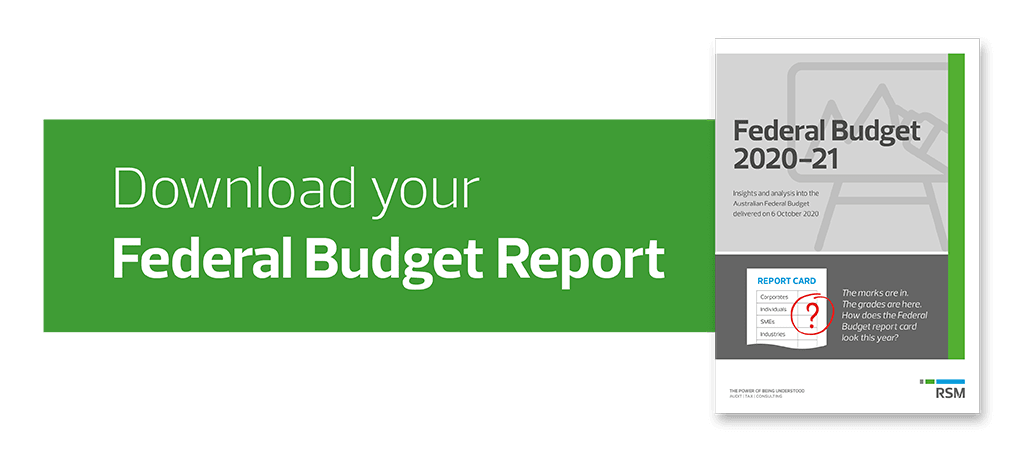What does the 2020-21 South Australian state budget mean for you and your business?
The South Australian State Budget is looking to restart the local economy by:
- providing a platform for businesses to grow;
- investing in local infrastructure; and
- continuing to put health and safety of residents at the forefront of the post-pandemic recovery.
Over the last 12 months, South Australia’s economy has been severely impacted by both the COVID-19 pandemic and major bushfire events. This is reflected in downward revisions in expected revenue from all major taxes over the forward estimates, including payroll tax, stamp duty and land tax.
The State Government had previously responded to these economic challenges by implementing a number of stimulus packages totalling $4 bn, including payroll tax waivers and deferrals, and land tax relief measures. This Budget builds on the earlier stimulus measures with additional tax relief and small business support measures.
The State Government is forecasting a budget deficit of $2.59 bn for 2020-21 and a further budget deficit of $1.42 bn in 2021-22. In addition to the adverse impacts of the pandemic and the bushfires, a significant reason for the budget deficits is a $1.34 bn shortfall in GST payments from the Federal Government, due to the massive reduction in overall GST receipts. Overall, budget deficits are expected to continue until 2023-24 wherein the State Government is forecasted to deliver a $406m surplus.
Key points | Economic Stimulus | Health & Bushfire response | Infrastructure program | Lower costs for households | Stamp Duty | Land Tax
The key points of the Budget are:
- Net government debt is expected to rise significantly over the forward estimates to close to $25 bn.
- The Government, together with funding from the Federal Government, has spent over $330m in direct measures designed to protect against COVID-19 infections (eg personal protective equipment). The health and safety of South Australians remain a key focus for the State Government, with over $83m spent on public health measures such as the State’s contract tracing system.
- Significant payroll tax relief measures, in addition to the payroll tax relief measures implemented earlier this year:
- all small and medium businesses with annual Australian grouped wages of up to $4m will pay no payroll tax for the period from April 2020 to June 2021.
- larger businesses with annual Australian grouped wages greater than $4m and who are eligible for the extended JobKeeper payment from 4 January 2021, also will pay no payroll tax for the period January 2021 to June 2021.
- larger businesses with annual Australian grouped wages greater than $4m and who were also adversely impacted by COVID-19 are able to defer their payroll tax due for the period April 2020 to December 2020.
- a payroll tax relief for 12 months for wages paid to eligible new apprentices and trainees who commence a relevant contract of training with an employer from 10 November 2020 to 30 June 2021.
- The State Government has expanded the pipeline of infrastructure projects over the current forward estimates to an unprecedented $16.7 bn, up from $12.9 bn in the 2019-20 Mid-Year Budget Review.
Overall, the State Government has prioritised jobs and growth over the medium-term at the expense of a ramp-up in government debt to deliver a stronger and more resilient economic position in the future. Given historically low-interest rates and the need to stimulate the local economy, this focus on rebuilding rather than austerity seems appropriate.
Economic stimulus 
The key element of the State Government’s support to businesses of all sizes through the economic downturn is the $4 bn stimulus package.
Significant components of the package include:
- $530m for the Business and Jobs Support Fund, which is supporting a range of initiatives including small business grants, payroll tax relief, land tax relief, the state’s contribution to the JobTrainer National Partnership Agreement, and the Tourism Industry Development Fund
- $265m for the Community and Jobs Support Fund which is supporting a range of initiatives including the Local Government Infrastructure Program, the housing construction stimulus package, the international students support package, and the Arts jobs and recovery package
- $220m to provide additional support for the Economic and Business Growth Fund to bolster the government’s longer term growth strategy through the long term transformation of the South Australian economy
- $120m for the Digital Restart Fund.
Health and bushfire response 
The health and bushfire crises during the last 12 months have resulted in significant investments in response, including:
- $305m towards bushfire response and recovery measures;
- $45m is provided over four years towards the costs of clean up, replacement and repair of damaged state government assets resulting from the bushfires on Kangaroo Island; and
- $897m to support health services and revise the timing of SA Health’s financial improvement targets in recognition of its focus on responding to the requirements of the COVID-19 pandemic.
Infrastructure program
The State Budget ramps up the planned infrastructure spending over the forward estimates to a record $16.7 bn.
This is broken out across a range of key priority areas, including:
- $6.9 bn for road infrastructure, not including the $8.9 bn that is to be funded to build the River Torrens to Darlington section of the North-South Corridor by 2030;
- $2.2 bn for water infrastructure;
- $1.7 bn for health facilities;
- $1.3 bn for school facilities;
- $782m for residential housing;
- $772m for public transport; and
- $204m for sports infrastructure.
Lower costs for households 
- From 1 July 2020, average households are saving approximately $200 a year on their SA water bills. This was achieved through the State Government revising down the value of SA water’s regulated asset base delivering huge savings for consumers.
- The 2020-21 Budget continues to fund Emergency Services Levy remissions of $90m a year. The saving in 2020-21 for an average household is $163.60.
- Compulsory third party reforms have resulted in average savings of $100 per car;
- The Budget continues funding for the doubling of sports vouchers for primary school-aged children’s swimming lessons and other sports participation (from $50 to $100).
- The rent relief scheme provides for two rounds of grants of up to $1,000 to residential landlords who reduce the rent of a tenant experiencing financial hardship due to the COVID-19 pandemic. Landlords can also receive up to a 50% reduction on their 2019-20 land tax liability on affected properties, where they have provided relief to affected tenants or lost income due to a vacancy.
- Households that receive the Centrelink JobSeeker Payment received a one-off boost of $500 as part of the 2020-21 Cost of Living Concession. For eligible homeowners, their 2020–21 payment of $215.10 became $715.10. Eligible tenants received $607.60.
Stamp duty
As expected, given the substantial reform to South Australia’s stamp duty regime in recent years, there were no proposed changes to either the rate or base of stamp duty imposed on dutiable transactions in South Australia.
Land tax
With effect from 1 July 2020, the State Government provided a range of land tax reforms that will reduce private land tax bills by approximately $189m over three years:
- The land tax transition fund, which provides support to taxpayers impacted by changes to the rules relating to the aggregation of land, will increase its rate of relief from 50% to 100% off the relevant increase in an eligible taxpayer’s land tax assessment in 2020-21.
- Landlords can receive up to a 50% reduction on their 2019-20 land tax liability on affected properties, where they have provided relief to affected tenants or lost income due to a vacancy.
- Commercial owner-occupiers who own the land where they operate their business will be eligible to receive relief of 25% off their 2019-20 land tax liabilities where they are eligible for the JobKeeper payment from 31 October 2020 and have an annual turnover of not more than $50m.
Businesses and individuals paying land tax quarterly in 2019-20 were able to defer payment of third and fourth quarter instalments for up to six months.
For more information
If you have any questions or require further information on the 2020-21 South Australia State Budget Analysis, please contact your local RSM adviser today.


